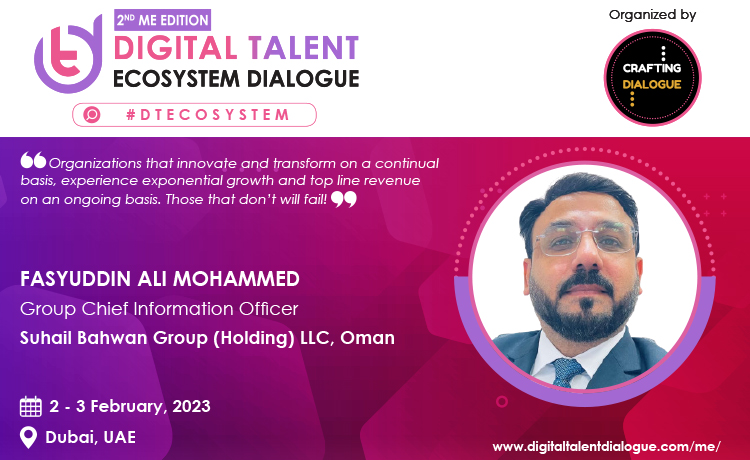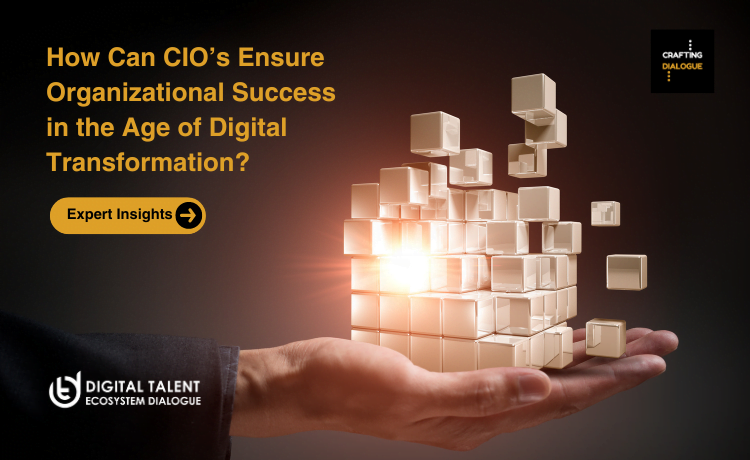How Can CIO’s Ensure Organizational Success in the Age of Digital Transformation?

CIOs now have an increased responsibility in building and nurturing the digital talent pool to drive organizations digital transformation efforts. The “2nd ME Digital Talent Ecosystem” featured speaker Fasyuddin Ali Mohammed, Group Chief Information Officer of Suhail Bahwan Group (Holding) LLC, Oman; shares his views on the evolving role of CIOs in the digital age:
1. How is technology revolutionizing “Future of Work” and what are your views on how tech leaders are preparing and leading their workforce for digital acceleration and future disruptions?
Technology world over is constantly evolving and change is being mandated on organizations in the quest for progression and profitability. Organizations are reinventing themselves digitally to thrive and are adopting business-centric approach to transformation. The goal is simple “Adopt today, for tomorrow”.
Technological advances such as automation, artificial intelligence and data mining are knocking substantial employment and are shaping the “Future of work”. It drives us towards a critical concern “future employment and work environment”. It must be a priority for thought leaders to focus and be able to find a balance between drive for transformation and skill management. Change will eliminate jobs and takeaway some occupations. However, this infiltration will also aid in creation of new jobs and requirement of new job-related skills. It is vital for us / C-suites to seriously plan for the future of business and ensure that workforce is supported with the following:
- Re-skilled to act as a value-add for business.
- Incentivise to develop, maintain, and tap new technologies.
- Enlighten the management on the Importance of technology apprenticeship and the fact that automation could augment and not replace workforce.
- Elevate from within and define a new way of working for workforce.
- Closely manage Succession planning and load balancing.

2. The role of tech leaders has evolved in this dynamic post-pandemic era. What are the new approaches to strategic decision-making when it comes to bridging the digital talent gap, digital workplace, and digital experience?
For corporates this is a pressing concern due to a huge mismatch. Post pandemic era has thrown open an epic challenge for CIO’s and technology leaders to secure organization’s digital workforce. Digital systems consultants, data imprint teams and advisors are required to monitor and guide organizations, 24/7. However, a range of initiatives can be adopted to address the vast Gap such as:
- Upskilling and reskilling has to become a mantra for organizations. These initiatives will play a key role in building a resilient workforce.
- Incentivise to develop, maintain, and adopt new technologies.
- Hire foreign workforce to bridge the digital skills gap. This needs independent evaluation as it is dependent on removing /relaxing restrictions for hiring foreign digital talent.
- Managed services could come to the rescue as internal hiring and retention will be an ongoing challenge.
- Involve multiple stakeholders across business, redistribute skills, and create opportunities to address mismatch.
3. Tech leaders are now actively reviewing and exploring new digital business models and ecosystem partnerships. What are your views on how tech leaders can ensure they are effectively leveraging technology for organizational advancement and competitive advantage?
Talent gap, competition for skilled workforce and hybridisation work model has forced technology leaders to go back to their drawing boards and redraw strategies that remediate the perils of digital workforce concerns. As thought leaders, redefining business models and strategy is the key, and it should comprise the following to leverage technology for organizations:
- Innovative work culture. (Challenge the set norms and adopt multi skill environments)
- Adopt business models that are collaborative and minimally people dependent. Leverage partner ecosystem and digital business models that guarantees 24/7 upkeep instead of owning, rent and employ services.
- Leverage the partner ecosystem by adopting the subscription model and create value by obtaining access, regular updates, services, enterprise platform support etc.
- Focus on employee value proposition and keep them engaged. Ensure the organization is attractive enough for employees to return.
- Work towards three-to-five-year roadmaps and adopt technologies that are agile and will become mainstream. Prepare your team according to roadmap.
4. When it comes to aligning customer experience and employee experience, why do you need a total experience strategy to drive CX and EX to transform business models?
The era of CX being the focus is fading fast. EX it getting its recognition, long due and rightfully so. As a thought leader, it is imperative in today’s world to build a total experience strategy where CX and EX collaboratively drive organizational change. Multiple surveys suggest progressive organizations are defining their strategies whose core objectives are customer experience and employee satisfaction. Those that fail to realize will find it difficult to outperform their competitors.
Employee experience is critical for a lasting and positive customer experience. CX and EX both go hand in hand and hence having total experience as a strategy is vital for successful business model. Supporting workforce on areas that will propel their performance is the responsibility of the leadership team and this has to be an important part of the total experience approach. This will ensure employee loyalty and retention.